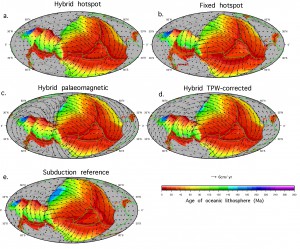 Absolute reference frames are a means of describing the motion of plates on the surface of the Earth over time, relative to a fixed point or frame. Multiple models of absolute plate motion have been proposed for the Cretaceous-Tertiary period, however, estimating the robustness and limitations of each model remains a significant limitation for refining both regional and global models of plate motion as well as fully integrated and time dependent geodynamic models. Here, we use a novel approach to compare five models of absolute plate motion in terms of their consequences for forward modelled deep mantle structure since at least 140 Ma. We show that the use of hotspots, either fixed or moving, or palaeomagnetics, with or without corrections for true-polar wander, leads to significant differences in palaeo-plate velocities of over 10 cm/yr as well as differences in the location of palaeo-plate boundaries of up to 30° in longitude and latitude. Furthermore, we suggest that first order differences in forward predicted mantle structure between the models are due mostly to differences in palaeo-plate velocities, whereas variation in the location of plate boundaries may contribute to smaller wavelength offsets. We present a global comparison of the absolute reference frames in terms of mantle structure, which we have tomographically filtered to reflect the resolution of the seismic tomography model S20RTS. At very long wavelengths hotspot models best reproduce the mantle structure. However, when geometry and the match of smaller-scale subducted slab volumes are compared, a hybrid model based on moving hotspots after 100 Ma and palaeomagnetic data before (with no corrections for true-polar wander), best reproduces the overall mantle structure of slab burial grounds, even though no single model fits best at all mantle depths. We find also that the published subduction reference frame tested here results in a modelled mantle structure that agrees well with S20RTS for depths >2500 km, equivalent to subduction before the Cretaceous, but not for shallower depths. This indicates that a careful assimilation of hotspot, palaeomagnetic and seismic tomography data into future absolute plate motion models is required to derive a more robust subduction reference frame.
Absolute reference frames are a means of describing the motion of plates on the surface of the Earth over time, relative to a fixed point or frame. Multiple models of absolute plate motion have been proposed for the Cretaceous-Tertiary period, however, estimating the robustness and limitations of each model remains a significant limitation for refining both regional and global models of plate motion as well as fully integrated and time dependent geodynamic models. Here, we use a novel approach to compare five models of absolute plate motion in terms of their consequences for forward modelled deep mantle structure since at least 140 Ma. We show that the use of hotspots, either fixed or moving, or palaeomagnetics, with or without corrections for true-polar wander, leads to significant differences in palaeo-plate velocities of over 10 cm/yr as well as differences in the location of palaeo-plate boundaries of up to 30° in longitude and latitude. Furthermore, we suggest that first order differences in forward predicted mantle structure between the models are due mostly to differences in palaeo-plate velocities, whereas variation in the location of plate boundaries may contribute to smaller wavelength offsets. We present a global comparison of the absolute reference frames in terms of mantle structure, which we have tomographically filtered to reflect the resolution of the seismic tomography model S20RTS. At very long wavelengths hotspot models best reproduce the mantle structure. However, when geometry and the match of smaller-scale subducted slab volumes are compared, a hybrid model based on moving hotspots after 100 Ma and palaeomagnetic data before (with no corrections for true-polar wander), best reproduces the overall mantle structure of slab burial grounds, even though no single model fits best at all mantle depths. We find also that the published subduction reference frame tested here results in a modelled mantle structure that agrees well with S20RTS for depths >2500 km, equivalent to subduction before the Cretaceous, but not for shallower depths. This indicates that a careful assimilation of hotspot, palaeomagnetic and seismic tomography data into future absolute plate motion models is required to derive a more robust subduction reference frame.
Here we provide a set of rotations and topologically closed plate polygons for the five alternative reference frames back to 140 Ma. The input files are ready for use with GPlates, an interactive plate-tectonics visualization software program, which is free to download. Please refer to the README file for instructions or to the tutorials for more information.
Documents
Paper – pdf
Datasets
If you use any of the resources, please cite the following publication Shephard, G. E., H-P. Bunge, B.S.A. Schuberth, R.D. Müller, A.S. Talsma, C. Moder, and T. Landgrebe. 2012. Testing absolute plate reference frames and the implications for the generation of geodynamic mantle heterogeneity structure. Earth and Planetary Science Letters 317-318 p 204-217 doi:10.1016/j.epsl.2011.11.027.
Feedback
We welcome any feedback.
![]()
